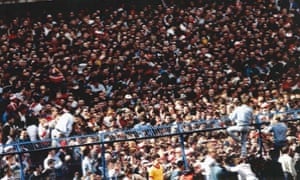Efforts to revive unconscious boy fail
The Guardian
David Conn
June 2, 2015

The Leppings Lane end of Hillsborough on 15 April 1989. Photograph: PA
Adam Spearritt, 14, was pulled unconscious over the fence in front of pen 3 of the Leppings Lane terrace during the lethal crush at the FA Cup semi-final between Liverpool and Nottingham Forest.
Sgt John Morgan said in a statement read to the Hillsborough inquest on Monday that he and a colleague carried Adam to the Kop end where, he said, police, ambulance and fire officers were tending to casualties.
David Pearson, a volunteer police constable, said he found two football fans giving Adam mouth-to-mouth resuscitation at the Kop end.
Pearson said he then took over, giving mouth-to-mouth resuscitation and chest compression, which he had never done before because he had undergone no first aid training. The only training he had had in resuscitation techniques was in his school days during swimming lessons, Pearson told the inquest.
Pearson said he was approached on the pitch by a doctor who pointed out that he was forgetting to pinch Adam’s nose while trying to revive him.
“I’m sure I was doing it earlier,” Pearson said, “but just at that particular time I wasn’t holding his nose, I was just breathing, and obviously the air was coming back out.”
Nevertheless, Pearson said, he was “100% confident” that he felt a pulse during his 15 minute-long effort to revive Adam.
Adam had gone to the match with his father, Eddie, who also passed out in the crush and who woke up on a ventilator in intensive care at Sheffield’s Northern General hospital.
In a statement given in 1989, Spearritt Sr said he tried to lift Adam out of the crush but could not get a grip of him, and a policeman at the gate in front seemed to take no notice of his screams.
Matthew Fenwick, a South Yorkshire police constable, told the inquest that he climbed over the fence into the pen and landed on a pile of people he believed were dead. He saw Adam on top of the pile and started trying to lift him over the fence. He said he believed Adam was alive at first but “the life seemed to ebb away from his body” as he was holding him.
Another PC, Fiona Nicol, on the other side of the fence, managed to haul Adam out with the help of a sergeant, Michael Roddis, and tried to revive Adam on the pitch at that end. Nicol, who said she had only “very basic” instruction in first aid during her initial police training, said she gave mouth-to-mouth resuscitation and heart massage for what seemed like “an awful long time” but felt no signs of life.
Nicol broke down in the witness box after describing how she was told, possibly by a St John Ambulance officer, that Adam was dead and to leave him.
“I received a tap on the shoulder,” Nicol said. “Another body was virtually placed next to me, and I just literally turned around on my knees and started heart massage.”
The inquests heard that the other body laid next to her was that of David Hawley, 39, another of the 96 people who died at Hillsborough.
After Morgan and another officer carried Adam to the Kop end and Pearson worked to revive him, Adam was taken on an advertising hoarding to an ambulance, which was driven at full speed to the Northern General hospital by a police officer filling in as the driver.
Trevor Dale, one of the ambulance officers, said there was good colour in Adam’s face and he responded well to having air pumped into his lungs, and Dale believed they had a chance of saving him.
After injections of adrenaline, atropine and other fluids at the hospital’s accident and emergency department, Adam’s heart began beating again and he was transferred to intensive care. However, his heart rate slowed again and a consultant doctor, George Clark, pronounced Adam dead at approximately 4.50pm.
At around 9.30pm Adam’s body was taken from the hospital back to Hillsborough, where the Sheffield Wednesday gymnasium was being used to house all the dead for identification. Adam was pronounced dead again by a different doctor at 10.05pm.
William McNiven, a friend of the Spearritts at the match, had been instructed by police to wait for news at the Hillsborough boys club, where he was eventually told that Adam was among people classed as “safe and well”.
McNiven called Adam’s mother, Janet, at 7.40pm to give her that news. He then went to the hospital, found Eddie was in intensive care, and called at 1am to tell Janet, who came over to Sheffield with Adam’s uncle Robert and waited at Eddie’s bedside.
McNiven went back to Hillsborough at 2.30am to identify a young boy, who was not Adam, and returned to the hospital where he was then told to go again to Hillsborough to view new photographs of 10 more people who had died. There, at 4.15am, Robert Spearritt identified his nephew Adam.
Janet Spearritt and her two other sons, Paul, now 35, and Daniel, 24, were at the court in Warrington, listening to the evidence in silence with their relatives, members of the Hawley family and around 100 people from other families whose loved ones died at Hillsborough. Eddie Spearritt died in 2011.
Judy Khan QC, representing the Spearritt family, thanked Nicol and Pearson for the efforts they made to try to save Adam.
The inquest continues.
 |
 |
 |
|
